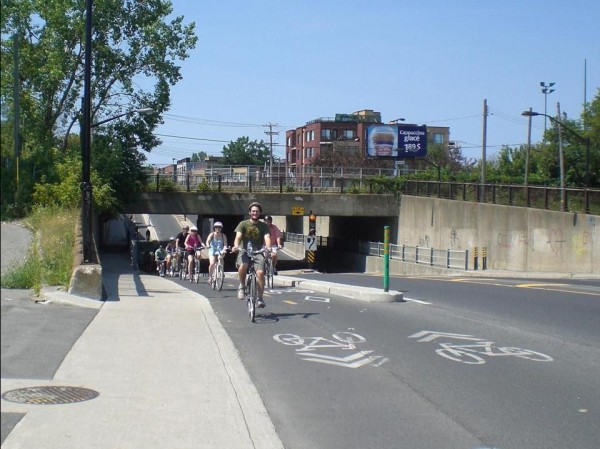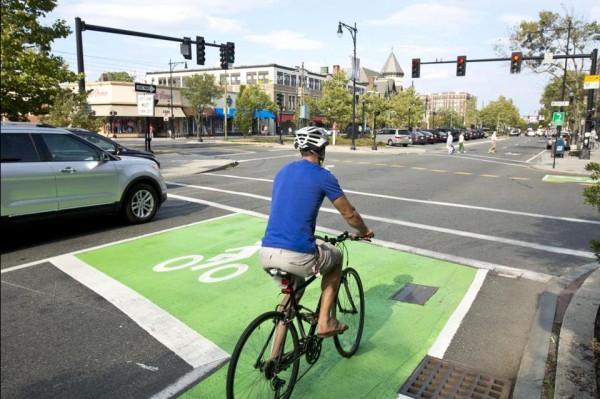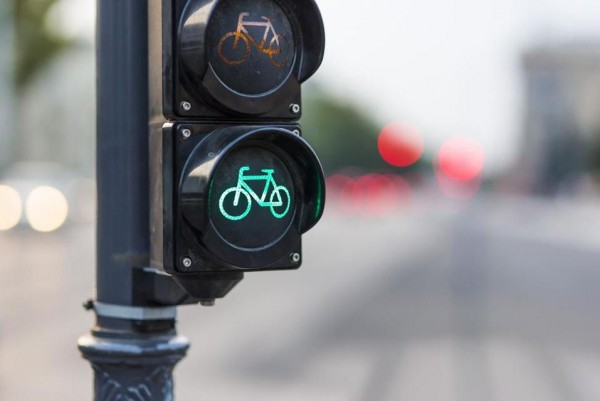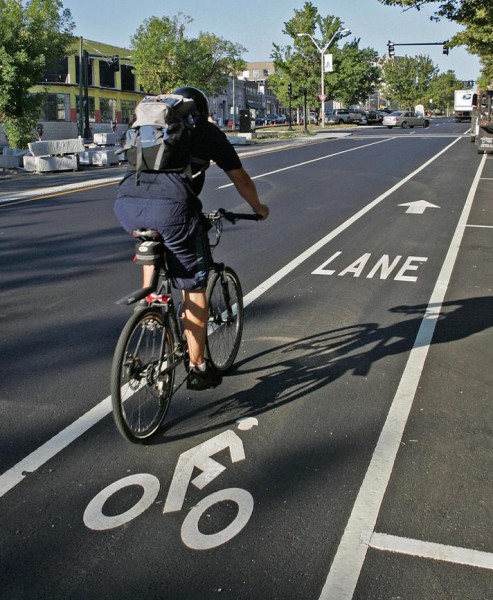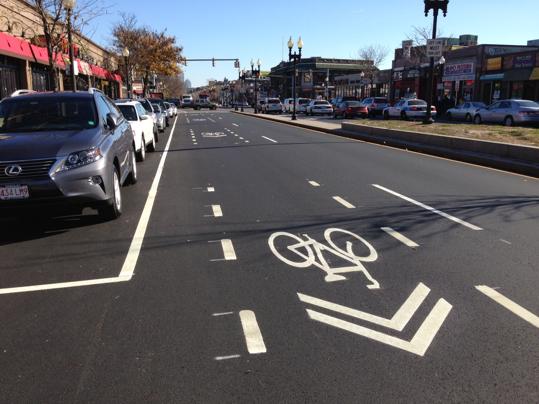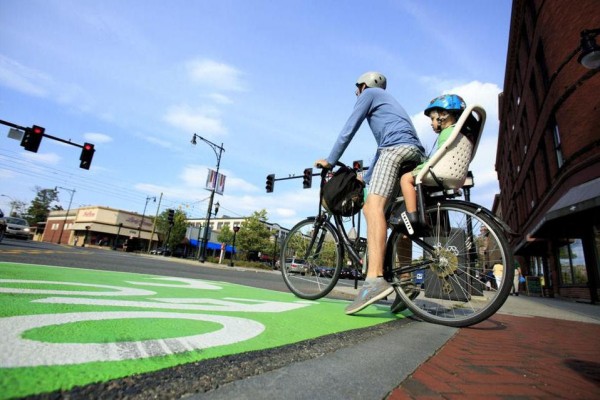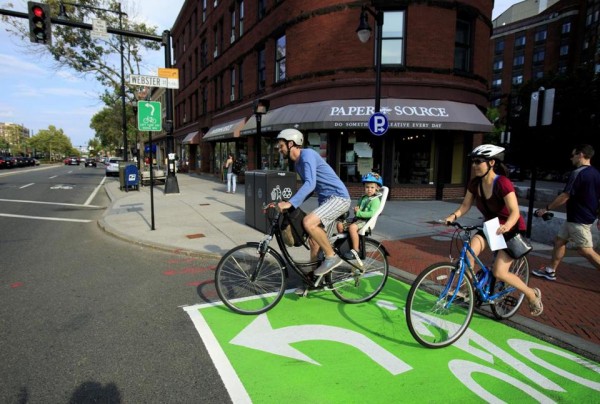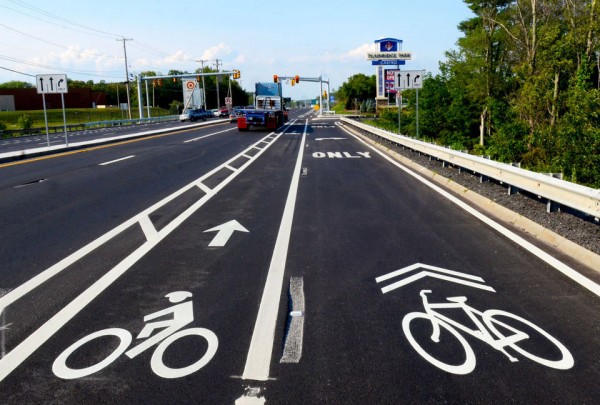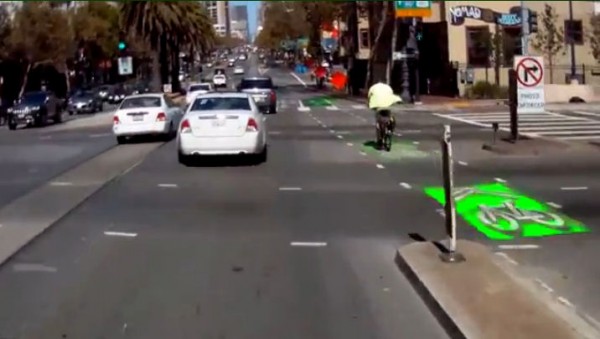This article is about Massachusetts Avenue in Arlington, but at a deeper level, it is about two very different approaches to bicycling.
I’ll start by recalling Massachusetts Avenue as it used to be.
Massachusetts Avenue was striped with two lanes. They were very wide, because there once was a streetcar line down the middle. The Avenue was wide-open and free for me and for other bicyclists who understood how to ride safely in a wide lane — keeping a constant distance from the centerline, allowing only enough space to our left for motorists to pass easily and safely. In this way, we kept enough space on our right to avoid walk-out, drive-out and right-hook threats.
Here’s a photo I took from the back seat of my tandem bicycle, in 1985.
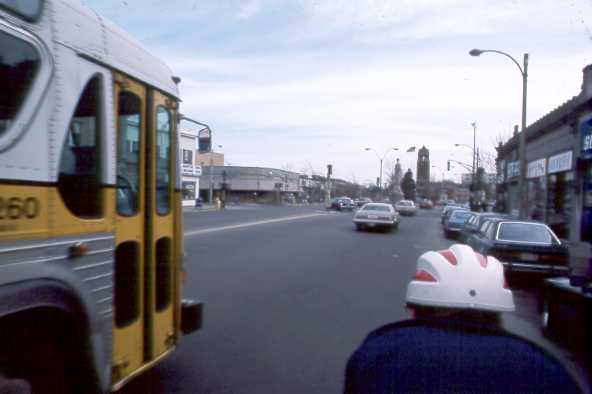
Cycling on Massachusetts Avenue, Arlington, 1985
This location in a Google Street View, as of December 2011 — not much different. My photo is not in the segment which has recently been restriped, but the street cross-section is similar and it’s the only photo I have.
Riding this way worked fine for me and other confident bicyclists. On the other hand, for bicyclists who ride at the edge of the street in fear of being struck from behind, and for children who are incapable of reliably following the rules of the road, Massachusetts Avenue was highly uninviting.
In early October of this year (2015), I rode to Arlington for an appointment with my dentist and found a newly-repaved, wonderfully smooth Massachusetts Avenue, still without lane stripes. I rode it the same way I always did.
The dentist told me that I needed a filling replaced, and I made another appointment.
Thursday, November 12, I rode to Arlington again, to get the tooth filled. Turning the corner onto Massachusetts Avenue from Chandler Street, I encountered a woman stepping out of her car, just as I called out to myself, in astonishment, “door zone bike lane!” Because, there it was, stretched out in front of me, and she was standing in it, a door-zone bike lane. The woman asked me why I said that, and I told her.
She told me that she had her own problem with the Massachusetts Avenue installation: she is a member of Arlington’s Disabilities Commission. Raised planters on the sidewalks, surrounded by granite curbs, are so close to the edge of the street that disabled people cannot unload wheelchairs from their vans.
But, let me get back to my own story. See for yourself, about the door-zone bike lane. Chandler Street is the one-way street coming in from the right in the photo below, one block east of Lake Street. If a car door opens in front of you, and you are riding at normal speed for a bicyclist, there’s no way to avoid the door except to swerve left. If the right-hand end of the handlebar nicks an opening door, that will sweep the bicycle out from under you to the right and topple you to the left, into the path of overtaking traffic. Riding in the door zone also leads to walk-out and drive-out hazards, right-hook and left-cross collisions.
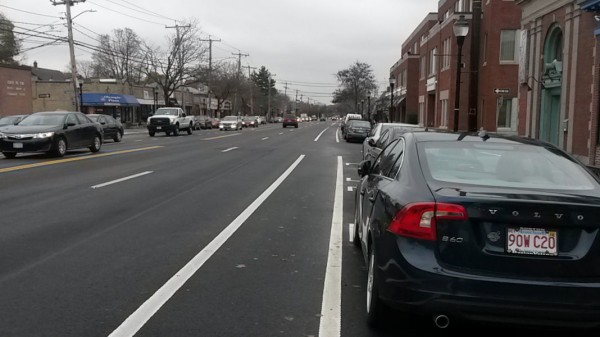
Massachusetts Avenue at Chandler Street
This location in a Google Street view, as of August, 2014
Here’s another example, looking to the west just after Winter Street.
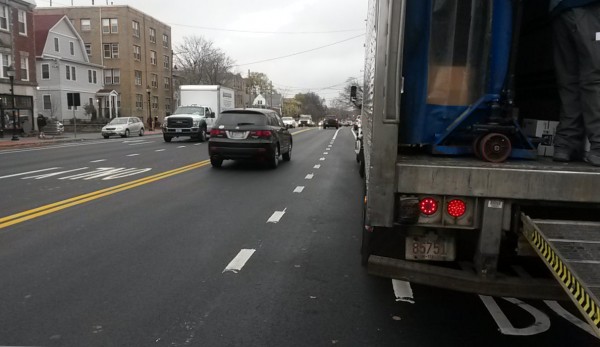
Westbound, truck unloading
This location as of September, 2014
Winter Street is opposite and slightly west of Lake Street, at the same signalized intersection. At the left in the photo are the three eastbound lanes –left turn, through and right-turn lanes. If you look past the truck, you can see cars parked up to the edge of the bike lane, even though it weaves farther toward the middle of the street after it passes the start of the left-turn lane.
Yes, the unloading truck is parked in a bus stop. The driver had no other choice. A bus at this bus stop would occupy part of the bike lane, the same as the truck. Riding safely past a stopped bus here requires controlling the travel lane, to be far enough away to avoid going under the bus if it pulls out.
From a public meeting early in the design process, I recall plans for a single travel lane and bike lane in each direction and a median, which could leave bike lanes outside the door zone and included more curb extensions than are in the final design. (Plans are accessible on the Town of Arlington Web site. The early plan I recall is here. The final plan is here.)
The Massachusetts Department of Transportation Project Development and Design Guide describes and advises integrated multimodal development: consideration should be given to walking and bicycling, as well as motor traffic. This project, however, was designed primarily to increase capacity for motor traffic: the width of the street has been divided into more lanes — as many as four lanes at some locations. There are two or three lanes at the few spots where there are median pedestrian refuges. The bike lane gets squeezed in against the parked cars.
It has been common practice for decades on Massachusetts streets and highways to stripe an increased number of lanes to increase capacity for motor traffic. A segment of a street or highway with two wide lanes would be restriped with four narrow lanes. A paved shoulder would be converted into a travel lane, sometimes only before intersections, sometimes for miles at a stretch. A left-turn lane would be added, by narrowing the through lane.
Streets striped this way can still work for bicyclists who possess the confidence to ride in the middle of a narrow right-hand lane, so motorists will wait for a safe opportunity to pass or pass in the next lane.
Now, with the bike lanes on Massachusetts Avenue, the same basic formula has been applied, except that the bike lanes got squeezed in. They are either entirely or partially in the door zone, except where there is no door zone because there is no curbside parking. The photo below is of one of the places with the most room , at the west end of the project.
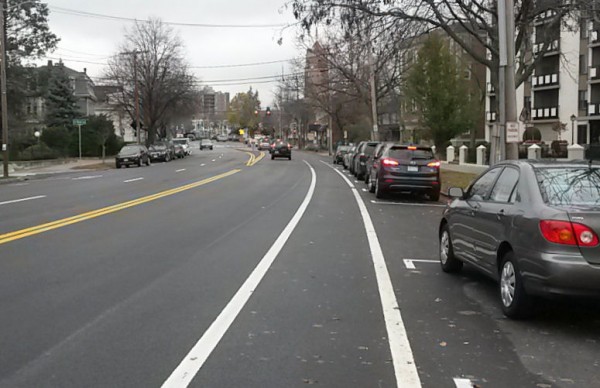
West end of project
The dashed lines in the photo below are supposed to indicate that motorists should merge into the bike lane before turning right, but what effect will those dashes have, with the huge right-turn arrow in the next lane?
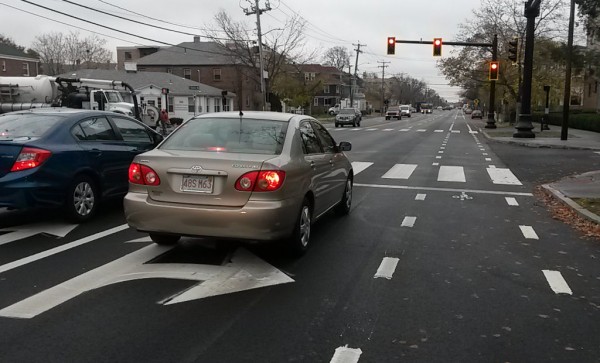
Mass Ave at Marion Street
This location in Google Maps, without bike lane, as of September, 2014.
The bicycle symbol in the bike lane is for a traffic-signal actuator. I’ve been calling out for bicycle-sensitive traffic signal actuators for decades, but the devil is in the details. The placement of this one encourages bicyclists to ride up to the corner, into right-hook territory, the “coffin corner”.
The “coffin corner” is the wrong place to wait, regardless. A bicyclist who reaches the intersection when no motor vehicles are waiting should wait in the lane to the left of the bike lane, so any motorist intending to turn right will pass on the right or wait behind. A bicyclist approaching the intersection when motorists are waiting might move ahead cautiously and slowly in the bike lane, but should not move up next to, or pass, the first vehicle waiting in line. It could turn right without the driver’s ever having noticed the bicyclist. These are basic principles of survival, unawareness of which has cost several bicyclists their lives in the Boston area over the past few years.
There are a couple of places where the bike lane is correctly placed to the left of a right-turn lane. Here’s one at Lake Street, a block before Chandler Street. I was standing facing east, directly opposite Winter Street.
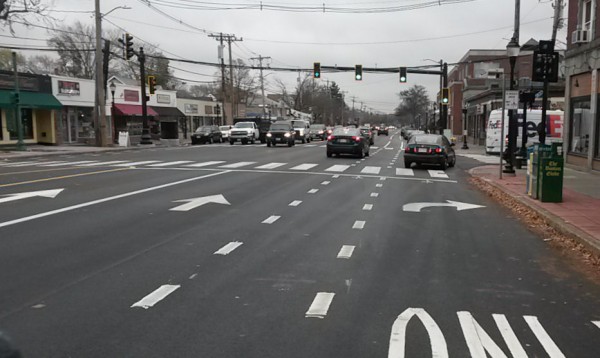
Right-turn lane at Lake Street
The right-turn lanes require the removal of a few parking spaces, and so they become the object of political battles. The parking spaces get removed only where right-turning traffic is heavy and a strong case can be made for right-turn lane to avoid traffic congestion. But only one motor vehicle is necessary to right-hook a bicyclist, at any intersection.
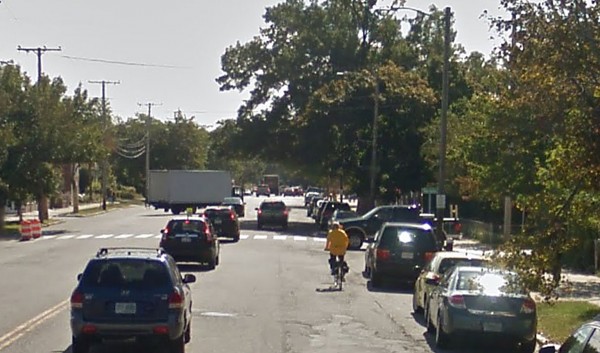
Edge rider on Massachusetts Avenue at Varnum Street
Now I’ll address the issue of different riding styles. The photo above, from Google Street View, is of of a bicyclist on Massachusetts Avenue who is keeping near the right side of the street. He is only marginally far enough from the parked cars to avoid dooring. The last parked vehicle short of the corner has been concealing him from the view of the pickup-truck driver who has pulled out far enough to see traffic approaching in a more normal lane position. If you click on the street surface in the street view online, you can follow this bicyclist most of the way down to Alewife Brook Parkway. You will see that he weaves left to pass around the front of the pickup truck, ducks into a gap between parked cars and passes several parked cars in the door zone. He disappears from the Street View for a while when he runs a red light and the Google camera car waits, but he reappears when it catches up.
Judging by this bicyclist’s size, his equipment and his riding on Massachusetts Avenue, he is an adult, regular bicycle user, yet he is riding contrary to basic principles of street safety. He is stuck in the edge-riding paradigm. That is how I rode too, for my first few years in Boston, until I read the book Effective Cycling, and learned to use the streets safely.
The next photo, as a counterexample, is a Google Street View showing a woman on a motor scooter waiting to turn left onto Lake Street. Her choice of the motor scooter, her confident use of the left-turn position and her clothing — especially the slippers — suggest that she is from Taiwan, where motor scooters predominate in street traffic, or maybe from mainland China. She is operating as a driver, the same way I do it on my bicycle. Good for her!
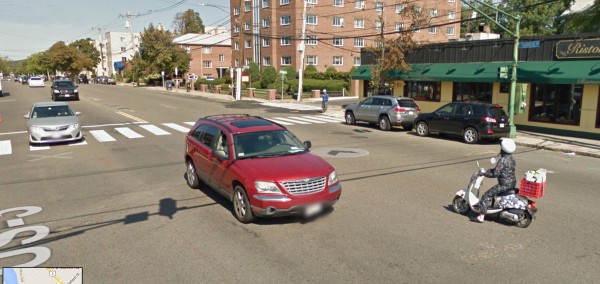
Left turn from Massachusetts Avenue onto Lake Street
Google Street View online
The new installation on Massachusetts Avenue makes no special provision for bicyclist left turns. The legal options are to turn left as a driver, as this woman did, or to use one of the few crosswalks.
At the far right corner of a few intersections in the Boston area, two-step turn queuing boxes have been installed: spaces for bicyclists to turn their bicycles 90 degrees to the left, wait, and then cross. These can be useful where a conventional left turn would be especially difficult, or is illegal. But they are practical only at intersections where a traffic signals stops the cross traffic, and they increase delay because it may be necessary to wait for the signal at both stages.
Now, let me draw some conclusions and make some projections.
Is the restriping with more travel lanes necessary to handle motor traffic volume?
There is a lot of excitement in the urban planning and advocacy community these days about how a smaller percentage of young people is getting driver’s licenses. There is also excitement about how more people are choosing to live in cities, or inner suburbs, so they will drive less. But nonetheless, with an increasing urban population, more people will be driving. My dentist told me that large apartment complexes are being built nearby. They all have parking garages. So, even if the percentage of people driving falls, their number will increase. It would take a major upheaval to get them out of their cars and onto bicycles, and onto the #77 MBTA bus which runs on Massachusetts Avenue.
How will the restriping affect safety?
I’m not an expert on motor-vehicle safety. I think that the redesign may improve it by slowing traffic: on the other hand, the street layout is more complicated. Time will tell. The curb extensions, clearly-marked crosswalks and new traffic signals are well known to improve conditions for pedestrians.
Bicycling safety is a different issue. As the example of the edge-riding bicyclist shown earlier illustrates, it’s hard enough convincing bicyclists to control the travel lane when necessary. But now, advice is painted on the streets reinforcing the hazardous behavior. The bike lanes direct bicyclists to ride into hazards, and also recruit social pressure from motorists to enforce that behavior: horn honking, yelling out of car windows and close passes. A bicyclist who rides outside the bike lane is perceived as a renegade, an outlaw, though there is no law against that in Massachusetts. I never used to get abuse in the Boston area for taking the lane position I need in order to be safe. Now I do, and frequently.
The door-zone bike lanes reinforce the incorrect belief that being struck from behind is the main hazard, and that riding in the door zone must be the best we can do, even though close calls quickly build a prevailing sense of unease about in the door zone.
Many bicyclists I see on the streets of the Boston area these days have no idea that they can operate as bicycle drivers, actively communicating and cooperating with motorists using lane positioning and hand signals. Only the few bicyclists who know better think otherwise. A passive approach to safety prevails: helmets, riding on paths, edge riding while on streets. Few understand that our safety as bicyclists is something we can, and should, take into our own hands. Doing or teaching that is becoming more difficult as road markings increasingly promote unsafe behavior.
The door zone bike lanes are also seeding a generation of motorists with the belief that This is My Space Over Here, and That is Your Space, and so, Stay Out of My Space.
I used to see all this as only leading bicyclists down a descending spiral of poor behavior. But it’s worse now. The bike lanes, the special space, are seen as an improvement — by bicyclists, motorists, public officials and planners. But inadequate bike lanes don’t solve the safety problems, and riding on the road as a bicycle driver is believed to be worse, and so the trend is that we must move in the other direction, to barrier-separated on-street bikeways. I see the advocacy community now increasingly pushing for them.
Barrier-separated bikeways are to be installed on Commonwealth Avenue in Allston, so we’ll get to see how that works out. I don’t think that is a good solution there, I think that there are better solutions, and I’ve explained why. I’ll have more to report when that actually happens.
But on Massachusetts Avenue in Arlington, I don’t see any such thing happening. The design which has only just now been implemented reflects existing demand for on-street parking, and projections of traffic volume which are probably realistic barring a major social upheaval. I do expect the volume of bicycle traffic to increase, but then it won’t fit into the bike lanes. Aside from their safety problems, they aren’t wide enough for one bicyclist to pass another. They may have made Massachusetts Avenue appear more attractive to some bicyclists, but if the crash rates on Commonwealth Avenue and the results of several safety studies in other cities offer any example, they do not offer safety.
There was some opposition to the Massachusetts Avenue project during the planning phase but that opposition was, was, in my opinion, a distraction, from an Arlington resident and his supporters who suggested that bicyclists could use the Minuteman Bikeway instead. The bikeway is very direct way to get from the center of Arlington to Alewife Station, but the bikeway gets farther and father from Massachusetts Avenue as it heads south. The opposition was reminiscent of Boston Globe columnist Jeff Jacoby’s suggestion that bicyclists should stay off the streets and go for a nice ride in the Arnold Arboretum. People aren’t going to go a mile out of their way, riding two sides of a triangle, to reach a destination on Massachusetts Avenue.
I supported the Arlington project, based on the early plans I saw, until I saw on November 12 how it turned out in the end. I don’t live in Arlington, so I didn’t pay it much attention after I saw the early plans.
I’d have been satisfied enough with the final design if the bike lane stripes had been omitted — or if there were only two travel lanes, so bike lanes could be placed outside the door zone — but that would reduce capacity for motor traffic, and capacity for motor traffic was clearly a major concern in the design of this project.
All in all, unfortunately, I don’t think that there is any good, practical, moderately-priced solution for Massachusetts Avenue in Arlington. Perhaps sometime, the USA will take the bull by the horns and work to solve its transportation problems. I can envision a subway under Massachusetts Avenue, or under the Minuteman, projects of the same scope as the 1980 Red Line extension to Alewife. These improvements would have some hope of decreasing traffic volume. But major improvements require raising taxes to pay for construction and maintenance. Heavy taxes on motor vehicles and fuel are an important factor in promoting bicycling in the northern European countries which are often held up as examples. Don’t hold your breath for that to happen in the USA. Or, maybe, do hold your breath, as the traffic goes by!
As for myself, I’m going to continue to use a safe lane position when I ride on Massachusetts Avenue. In most places, motorists have a passing lane, or if not, the right-hand travel lane is wide enough to share. But not everywhere, and where it isn’t, riding in a safe lane position will be more difficult, thanks but no thanks to the bike lane striping and the attitudes it fosters.
I encourage other bicyclists to do as I do. You may need to grow a thick skin to cope with horn honks, but your safety is more important, and it builds character.











